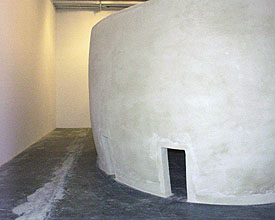Oh, No, Another Minimalist!
John Haberin New York City
Jene Highstein
I had been happily cutting myself a break for the summer, writing little, putting off museums in favor of easy walks in the relative quiet of New York summers. I know I had been meaning to check out Meret Oppenheim, the creator of the famous fur-lined teacup so evocative back in Surrealist days, at the Guggenheim, if for no other reason than that I could always claim she was not my cup of tea. Instead, I stumbled one Saturday into the Ace Gallery. 
It is one strange space—part adventurous, part spooky, part grand, part corporate—in a building on Hudson Street, a broad, usually quiet street a few blocks west of Soho, toward the Hudson River. I looked about and tried to think: Are there still enough active warehouses around here to help fill the few but occasionally hip bars? Are all these cars just on their way to New Jersey or to somewhere still more foreign to this fringe of New York? Will Greenwich Village or Soho ever really catch on this far? Finally I walked in and thought I had stumbled into the wrong door, into the gallery office, only the woman at the desk had her back to me.
Apologetically I kept going, past a desk of handouts and a modest monochrome relief painting that looks like a high-school science project that got squashed and mounted. And that is it. The gallery is over. Or is it? No, wait, there is another door, and without apologizing this time I opened it, and at last I was inside for real.
The Grecian urn
Actually, that relief painting is by by Jannis Kounellis, and what I found within is a hall as long as most city blocks, with rooms off to the side. It would be like a high-school corridor were it not so clean and so imposing, and each room is itself massively scaled yet necessarily more intimate than the public hallway. Then too, each is shaped differently, begging for a special, creative construction. Was even Minimalism ever site-specific and radical enough to take this on?
Okay, I have been exaggerating. Actually, I have seen a few shows there now, but this is, inadvertently, the funniest. Jene Highstein graduated college in 1963—the class of Minimalism, one might say—in philosophy, naturally. Apparently he has been making large-scale public sculpture, and getting a public for it, quite as long as others of his age, although I, for one, had never heard of him and cannot even pronounce his first name safely.
In the corridor, one's eye is caught by many drawings, large curvy silhouettes, the black shapes floating on white paper as if in empty space, begging to be called sculpture themselves. And then one looks up and to the right, toward an enormous concrete shape, again with rounded edges and a bloated middle. And it might be a good time to start giggling, before anyone can even joke, "What's a Grecian earn?"
The problem is that it looks like more than a container for a precious liquid. It looks downright gaseous, as if it had just been puffed up way beyond its or indeed anybody's natural dignity.
Every room off to the side is like that—finely crafted, aptly chosen to match the space, carefully tailored of either reinforced concrete or steel tubes. I desperately wanted to praise it, for managing to imply both sides of poured concrete, its fluidity and its bulk—as well as both sides of sculpture, its presence and its flowing response to the space and the viewer. And I just could not. Instead it looks too much like the scene in Woody Allen's early film where the blob takes over the countryside.
Object and opera
The problem is best traced back to those drawings. They invoke the wonderful idea of Abstract Expressionist painting and sculpture, of drawing in space, but with the reduced forms and "objecthood" of the next generation, the Minimalists. It is thus oddly conservative, never as involved in its space and its viewer's life as Minimalism was to become—and thankfully, sometimes still is. It was always far, far too firmly an abstraction, a purified sculpture, an object for contemplation. The result is a very personal kind of art trying too hard to maintain its dignity on the scale of comic opera.
The steel tubes are less ambitious but may have worked much the best. They cling to the walls and ceilings; they pull together or divide confusingly long, tall rooms, depending on where you stand. They keep their status as art objects without undue pretension. They let each visitor choose what they become—and who or what both art and the viewer are.
It was a fun show anyhow. It reminded me of the dilemma of my favorite abstract painters today, in the face of postmodern attacks and of the bulky institution now called Modernism. Do they retreat into a personal vision or blow themselves up into oversized aspirations? Even video artists can manage to do both—or neither.
Did I need more to be awed or to laugh? Either way, as I overate later, on a long detour home from Soho through Chinatown, Little Italy, and the Village, I felt suspiciously bloated myself.

Jene Highstein's installation ran in the summer of 1996 at the Ace Gallery. He also showed in 1998 in the Socrates Sculpture Park.




